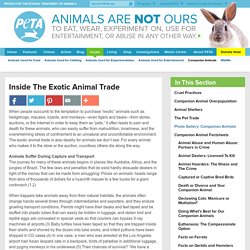

Save Tigers Now. A century ago there were 100,000 tigers roaming the forests, swamps, and tundra of Asia.

TODAY, there are as few as 3,200 left in the wild. Only 7% of historic tiger habitat still contains tigers. At this rate, wild tigers will be extinct in just a few decades. Illegal Trade Consumer demand for tiger parts poses the largest threat to tiger survival. Demand Tiger bones have been used in TAM for a wide variety of ailments for more than 1,000 years. Parts from a single tiger can fetch as much as $50,000 on the black market, making the poaching of these magnificent creatures very alluring to criminal networks. Claws, teeth and whiskers are believed to provide good luck and protective powers. Black Market Demand Uses of tiger body parts in various cultures that is driving the poaching of wild tigers. Tiger Farms Despite the fact that all international commercial trade of tigers has been banned since 1987, some countries allow the breeding of captive tigers on a commercial scale.
Who’s Responsible? Inside The Exotic Animal Trade. When people succumb to the temptation to purchase “exotic” animals such as hedgehogs, macaws, lizards, and monkeys—even tigers and bears—from stores, auctions, or the Internet in order to keep them as “pets,” it often leads to pain and death for these animals, who can easily suffer from malnutrition, loneliness, and the overwhelming stress of confinement to an unnatural and uncomfortable environment.

The exotic animal trade is also deadly for animals we don’t see: For every animal who makes it to the store or the auction, countless others die along the way. Animals Suffer During Capture and TransportThe journey for many of these animals begins in places like Australia, Africa, and the jungles of Brazil. The few laws and penalties that do exist hardly dissuade dealers in light of the money that can be made from smuggling: Prices on animals’ heads range from tens of thousands of dollars for a hyacinth macaw to a few bucks for a giant cockroach.(1,2) Disease ThreatThe U.S. TRAFFIC: The Wildlife Trade Monitoring Network. Plants and animals are traded for a range of uses – live animals for the pet trade, reptile skins for leather products, marine species for food and knick-knacks, and plants for horticulture.

Illegal and unsustainable wildlife trade often involves the transfer of goods across porous borders and is frequently characterized by the involvement of organized criminal syndicates. In order to successfully combat this trade and those groups and individuals perpetuating it, governments must coordinate their efforts. In 2005, The Association of South East Asian Nations Wildlife Enforcement Network (ASEAN-WEN) was launched and brought together ten nations in Southeast Asia to help combat illegal trade in species.
This network has helped catch and convict poachers and wildlife smugglers and has removed thousands of dollars of illegally traded wildlife off of the market. TRAFFIC is supporting the creation of a similar Wildlife Enforcement Network for Central America called ROAVIS. Can local sustainable development save the Amazon? Local sustainable development 2.0, that’s how we should call what is happening in 80 municipalities of the Brazilian giant state of Pará, in the Amazon region.

Pará is 1.8 times the size of Texas. These 80 towns are basically dominated by cattle-ranching and some timber production. Beef, timber, and soybean have been the main culprits for a long history of illegal logging, that has claimed about 20% of the Amazon rainforest, and 27% of Pará’s forest cover. Until recently, local development in the Amazon has been based on small scale cooperative-based extractive activities for the production of rubber, fruit or fish. Now local development has to address large-scale production, usually for beef, soybean, and wood products exports. Deforestation has declined sharply over the last five years, from more than 25,000 sq. The state government has recently launched the “green town” program aiming at stopping deforestation. Paragominas, was the first municipality to react. Illegal Wildlife Trade. Credit: USFWS Illegal wildlife trade is estimated to be a multibillion-dollar business involving the unlawful harvest of and trade in live animals and plants or parts and products derived from them.

Wildlife is traded as skins, leather goods or souvenirs; as food or traditional medicine; as pets, and in many other forms.